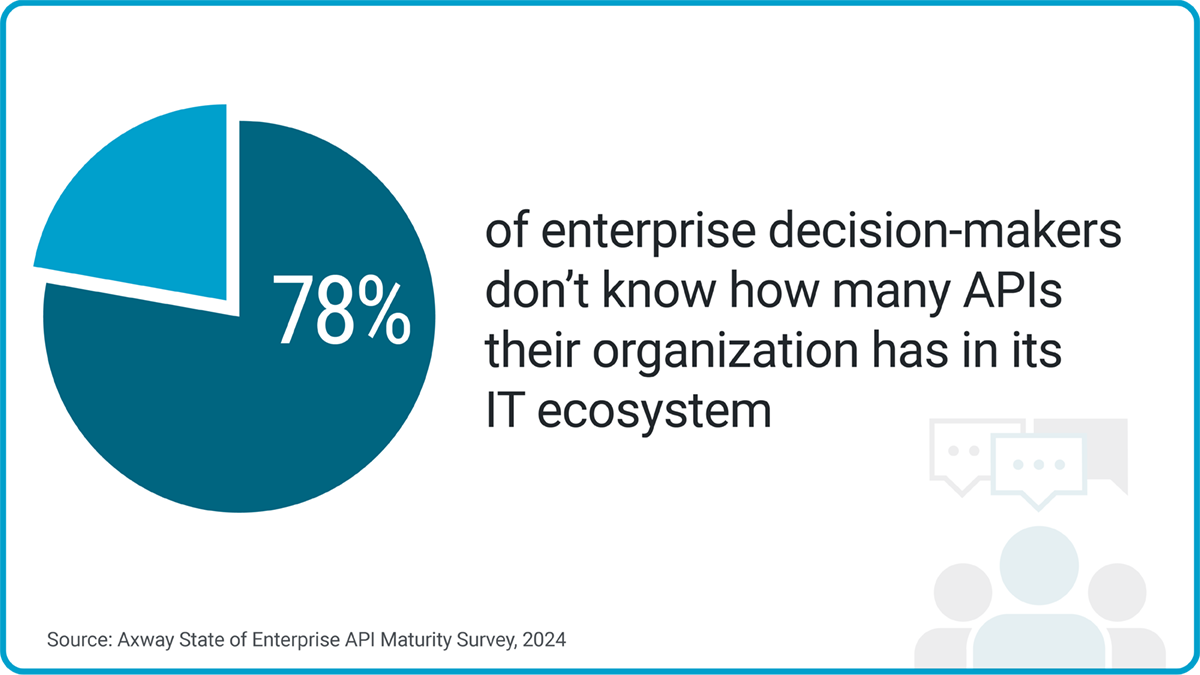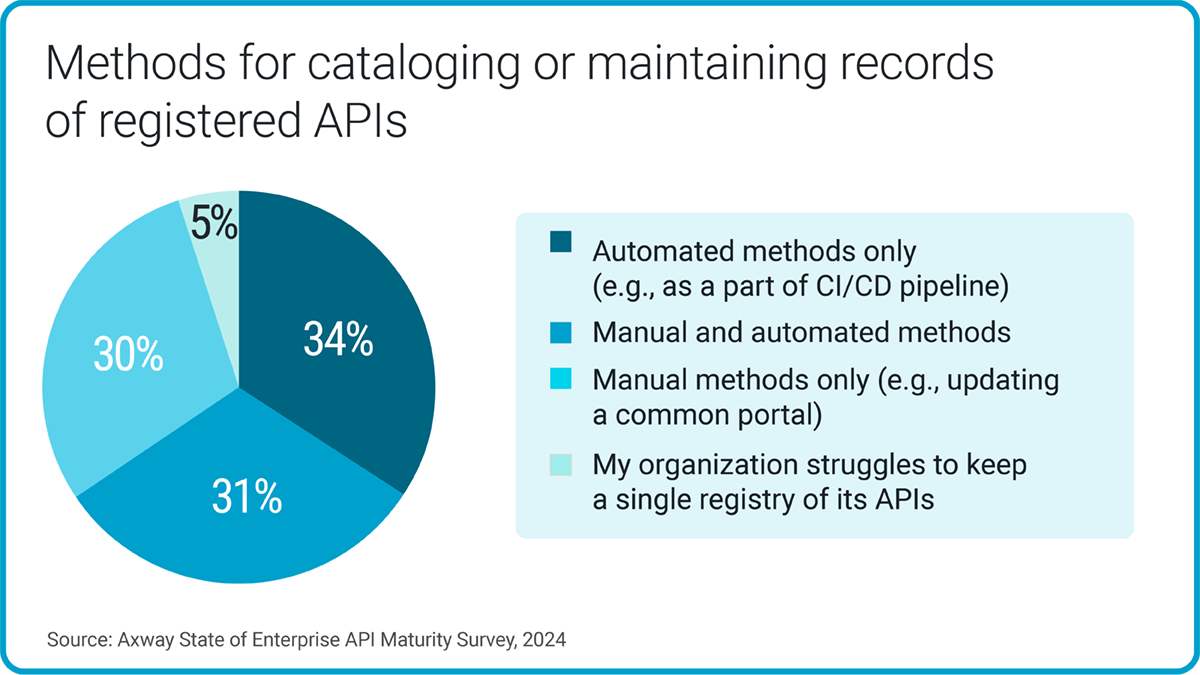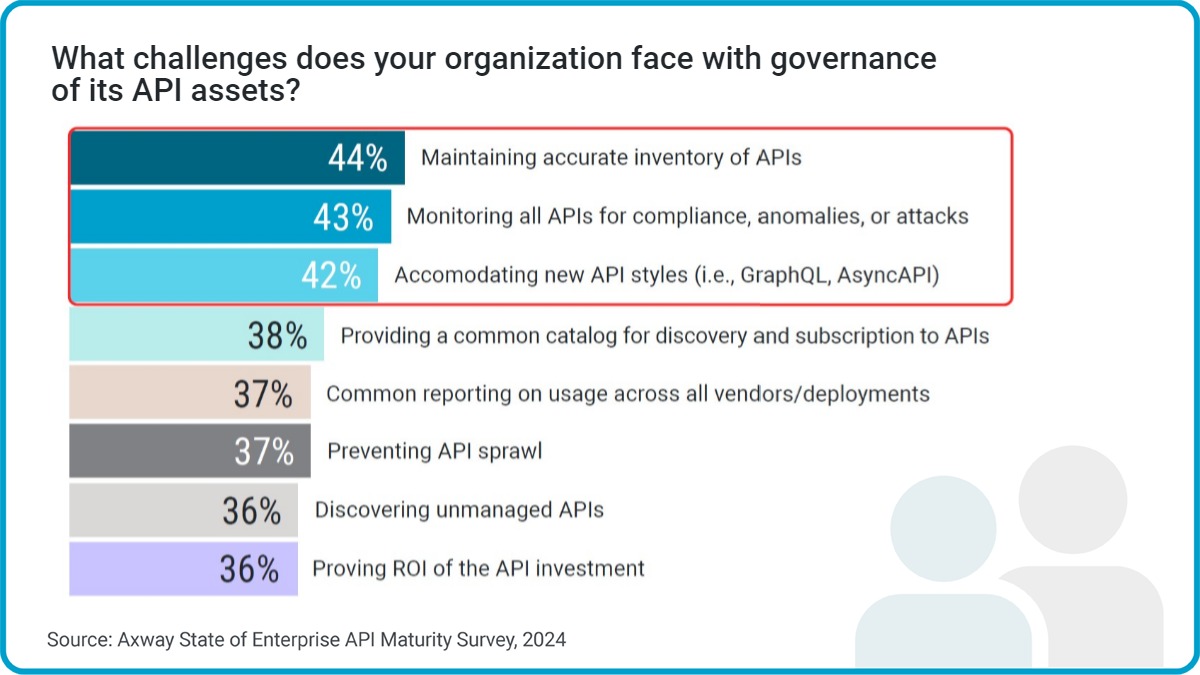API governance plays a crucial role in shaping the success of an enterprise’s API strategy – and in maximizing the value these assets help create across the entire API landscape.
Read on to understand the role of API governance in modern enterprise strategy, explore best practices, and understand how API management, API security, and even developer experience (DX) factor into the equation. Let’s dive into the world of API governance and consider how it helps align your API strategy with your enterprise goals.
What is API governance?
API governance refers to the set of policies, processes, and procedures that ensure the effective management and control of APIs within an organization. It involves establishing guidelines and standards for API design, development, deployment, and usage to ensure consistency, security, and compliance – for both API producers and consumers.
API governance focuses on optimizing the value of the entire API landscape, not just individual APIs. A good API governance framework ensures that access is regulated, security is maintained, and compliance standards are upheld, all while facilitating seamless integration and collaboration.
There’s an inherent tension between centralized policy enforcement and globally distributed, agile teams. It’s why the question of API governance often comes up in organizations past a certain size.
Dive Deeper into API Governance at the Enterprise Level
Why does API governance matter?
At the heart of the API governance question lies one of the primary goals and advantages of using APIs, as well as the potential challenges associated.
APIs often are part of an effort to move towards a more loosely coupled way of how IT and organization work. By breaking up monolithic structures, it becomes easier to change things, to add new capabilities, and it improves the ability to innovate and iterate.
The goal is to decrease coupling, and the path is to connect digital building blocks through APIs and design them to be used and reused easily.
But by reducing centralized development in this push towards a more agile organization, you lose some central control.
This brings us to a major challenge in today’s API landscape: API sprawl, the unchecked growth of APIs in organizations that increasingly operate in a multi-cloud, multi-team, and multi-gateway environment.
The current state of API governance
Axway’s 2024 State of Enterprise API Maturity report reveals that organizations face significant governance gaps as they tackle this complexity.
Organizations may be developing and using a growing number of APIs, but they don’t have good visibility over their ecosystem. Consider, for example, who is managing all these APIs, or how the inventory of APIs is being cataloged and maintained.
Only 1/3 of APIs are being managed by a centralized operations team. The rest are left to individual internal teams or managed by external parties.
Still according to this study, maintaining accurate inventory of APIs tops the list of enterprise challenges, followed immediately by monitoring all APIs for compliance, anomalies, or attacks and accommodating new API styles.
Download the full API maturity report here for more insights.
The question, then, is how to make sure that the decentralized components follow certain guidelines that are built and provided in a way that helps the overall goal of breaking up monolithic structures into loosely coupled capabilities.
“API governance reflects this challenge,” says API author and expert Erik Wilde. “It addresses the question of how to get the benefits of increased agility, while still keeping some centralized overview and control of the capabilities that exist and get developed.
Looking at it this way, API governance is similar to API Product Management. But whereas API Product Management is concerned with the lifecycle of a single product, API governance is focusing on the entire API landscape.
You could therefore say that API governance is for API landscapes what API Product Management is for individual APIs.”
A universal or federated API management approach can help strike this balance by providing a single pane of glass. It helps reduce risk and streamline processes without disrupting existing development centers.
See also: The balancing act of API governance
API governance vs. API management
At this point, you may be wondering, what is the difference between API governance vs. API management? They are related, but to put it simply:
API governance is the broader concept that encompasses the policies and processes for managing APIs, while API management is the implementation of those policies and processes using dedicated tools and platforms.
Essentially, you can look at it as API governance setting the guidelines, while API management provides the means to enforce and manage those guidelines effectively.
The question of API security
API governance and security tend to go hand-in-hand, as the familiar adage “you can’t manage what you can’t see” reminds us. And unseen, unknown APIs represent the largest attack vector in most organizations today.
See also: From Zombies to Legacy or Shadow APIs, it’s time to remediate your lost APIs
If with API governance, we seek to have a global view of an enterprise’s landscape, securing those APIs will be an inevitable part of the process of governing and managing assets.
API Security Tools and Best Practices
API governance trends
API management was initially seen in a very narrow way, managing single APIs by performing tasks such as authenticating and authorizing access to the API, preventing unauthorized access.
With the explosive growth of APIs, API management evolved to cover the entire lifecycle of an API, along with the development cycle of releasing, testing, deploying, and updating the API. We started seeing additional components such as testing and monitoring tools.
By late 2023, analysts were recognizing a new shift in the evolution of API management – what Erik Wilde has called the “great unbundling.”
This reflected market changes and the state-of-the-art in modern API management.
Businesses began shifting from comprehensive suites that encompass API planning, design, testing, gateway, portal, and lifecycle management to a more modular approach. They started integrating various vendor tools, such as using an API testing tool from one provider and an API gateway from another.
As Axway Chief Product Officer Vince Padua notes,
“We now live and work in a very distributed environment, and we need flexibility and adaptability in the tools we use. Developers need a more cohesive experience. Unfortunately, many API management solutions have failed to evolve with this pattern.”
What’s more, API gateways themselves evolved. “We saw the signs early on,” Padua continues. “Bloated API gateways, overloading of functionalities… We recognized that the industry was heading towards a cumbersome model that would eventually become unsustainable.”
Axway’s approach in driving this evolution was straightforward: offer a flexible and adaptable solution, allowing businesses to embrace a more streamlined and efficient model.
“Our commitment to the BYOG (Bring Your Own Gateway) philosophy wasn’t just a marketing slogan,” concludes Padua. “It was a direct response to the challenges our customers were facing. We want to empower them with the freedom to choose, integrate, and evolve without being shackled by a one-size-fits-all solution.”
A large part of this evolution has been driven by API federation – a key concept for universal/federated API management.
“In essence, API Federation underpins a strategic move towards a more agile and innovative API usage, impacting organisational (sic) structures, team dynamics, and digital execution culture,” writes API consultant Daniel Kocot.
“Success in this transition hinges on balancing the federated model’s flexibility with the necessity for strategic coherence and security across the enterprise, enabling APIs to drive digital transformation and competitive advantage.”
The New Stack: API Management Is a Commodity: What’s Next?
API governance strategy
With some definitions and history established, what are the goals of API governance, and how does one build an API governance strategy that satisfies these aims?
Per Erik Wilde, “The ultimate goal is to make sure that an organization gets the most out of its APIs: The value created with the help of APIs should be maximized across the entire API landscape.
The landscape perspective is helpful because it also captures scenarios that are outside the visibility of individual APIs, such as the value that is created when APIs are coherently designed and thus it becomes easier for developers to tap into the entire ecosystem on an organization’s API landscape.
The goal of API governance is to maximize the value produced by an API landscape, which has a lot to do with making sure that the User Experience (UX) makes it easy for valuable applications to be developed in that landscape.”
As he points out in the following video, the path of API governance – i.e. how to govern APIs – has a lot to do with improving Developer Experience (DX) so that these applications can be built easily and can be operated securely and reliably.
To dive deeper, Wilde’s video below provides some API governance examples and also describes approaches for how to put effective API governance in place.
How to govern APIs: best practices
When APIs are coherently designed, their value is more apparent, and it becomes easier for developers to tap into the entire ecosystem of an organization’s API landscape. With that in mind, here are some best practices to consider when laying out your API governance strategy.
- Establish clear governance policies. Centrally monitor and enforce policies around API development, usage, security, and compliance to ensure consistency and alignment with organizational objectives and regulatory requirements.
See also: Round up & secure APIs for universal API management
- Automate API validation. Perform semantic checks on APIs to ensure they meet all corporate and security standards and are free of issues (also called linting).
Hands-on with Spectral: Using API linting for better API design and API governance
- Standardize API design. Enhance interoperability, usability, and developer experience across the organization.
See also: What Hyrum’s Law means for API Design and Management
- Implement versioning. Manage changes and updates to APIs throughout their lifecycle while minimizing disruption to existing consumers.
- Maintain a central API registry/catalog. Axway’s State of Enterprise API Maturity report showed clear consensus on how enterprises could gain better oversight of their APIs: 95% agree that a centralized API catalog would improve the governance of APIs.
This can be done manually as part of CI/CD pipelines, but it is time-consuming and prone to human error. Automating the process using independent scanners in a central management plane helps avoid the inevitable “zombie” APIs that so easily go undetected in large, distributed organizations.
Bringing federated API management to life with expanded Amplify Agents
- Ensure every API style is supported. Today’s enterprises are leveraging newer API models beyond classic REST APIs such as events and integration flows, spread across multiple clouds from multiple providers.
- Enforce authentication and authorization. This can be further automated through role-based access controls, API key management, and authentication/authorization mechanisms that help enforce security policies and protect sensitive data.
See also: How to easily secure your APIs with API keys and OAuth
- Secure APIs. Apply practices such as encryption, rate limiting, and threat detection to mitigate security risks and protect against potential vulnerabilities.
Discover 12 API security best practices
- Provide comprehensive API documentation. Include usage instructions, endpoints, parameters, and response formats, to make it easier for developers to adopt and troubleshoot APIs.
- Monitor and adapt. Analytics and monitoring capabilities that track API usage, performance metrics, and consumption patterns in a single pane of glass help automate the product feedback loop and make smarter API investment decisions.
Bonus API governance tip: offer a great developer experience
Nudging API developers through guidelines and infrastructure can help shape the API landscape in a desired direction.
Community engagement features like ratings, reviews, and comments help drive greater API adoption because users can make more informed decisions based on community feedback and support.
Even more effective than laying out rules and guidelines is providing the tooling and automation that simply make it easier to “do the right thing” in the first place.
- If validation and securing of APIs is done programmatically, API product quality will increase.
- If APIs are easier to productize and publish, you can reduce time to market.
- If APIs are more easily found and used, such as by streamlining onboarding, you can drive greater API adoption.
5 reasons why Amplify Engage is the developer’s dream API portal
API governance tools such as an API marketplace help by ensuring rules are followed and automatically enforced, both inside and outside of the organization.
It’s why providing a stronger user experience will not just strengthen your API governance; it will help maximize the value generated from your API landscape.
Amplify Engage extends API governance and security to the enterprise level. Internal and external app developers can find and subscribe to API products regardless of where they are hosted, or which development team created them.
Along with validating compliance, defining access, and enforcing usage plans, Amplify Marketplace uses agents to discover APIs automatically, including unmanaged or duplicate APIs that drive up security risks.
By publishing APIs in a central location – tested against company security and design policies, well documented, and with a clear pricing model, service levels, and a process to report bugs and request changes – you’re able to ensure the tight governance needed to secure every API product.
Learn how you can unify cross-team API governance and security with Amplify Engage.





